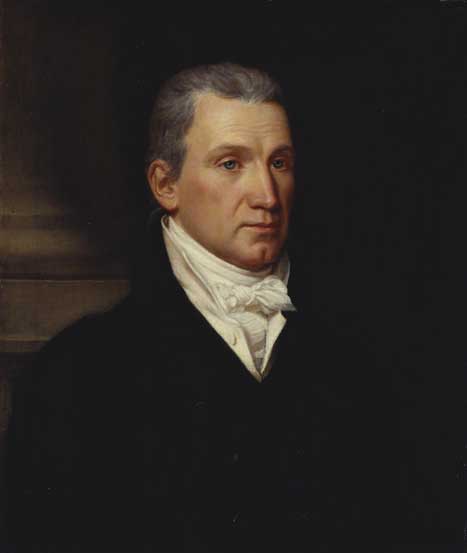James Monroe: "The Era of Good Feelings"

This article is written by Caroline Larson, an Art History and French major from Brigham Young University who is interning at the National Portrait Gallery. She writes about John Vanderlyn’s 1816 portrait of James Monroe, owned by the Portrait Gallery.
This blogpost originally appeared July 8, 2010
James Monroe was born on April 28, 1758, in Westmoreland County, Virginia. He enrolled at the College of William and Mary for two years but left in 1776 to enlist in the Third Virginia Regiment. He served as a lieutenant, major, and aide to General William Alexander before beginning to study law with Thomas Jefferson. In 1782 Monroe was elected to the Virginia House of Delegates and served as a delegate to the Confederation Congress from 1783 to 1786. He married Elizabeth Kortright in 1786 and began practicing law in Fredericksburg, Virginia.
Monroe was elected to the U.S. Senate in 1790 and worked with James Madison to establish the Democratic-Republican Party. Appointed minister to France by George Washington in 1794, Monroe worked to maintain friendship with that country. From 1799 to 1802 he was governor of Virginia. In 1803 Jefferson appointed Monroe to assist in buying a port on the Mississippi. Although unauthorized for the action, Monroe and his colleagues accepted Napoleon’s offer of the Louisiana Territory. Monroe then served as minister to Great Britain from 1803 to 1807. Madison appointed Monroe secretary of state in 1811 and secretary of war in 1814.
In 1817 Monroe became the fifth president of the United States. This heralded the beginning of what became known as the “Era of Good Feelings” and a temporary end to the two-party system with the death of the Federalist Party. Monroe was the last of the Revolutionary generation to hold the presidency.
Most of Monroe’s most noteworthy achievements as president were in foreign affairs. On December 2, 1823 he declared that European interference on the American continent would be regarded as an unfriendly act and that the Americas were closed to further colonization. Later known as the Monroe Doctrine, his declaration received little notice at the time but became key in future American foreign policy.
Monroe also secured Florida for the United States with the Adams-Onis Treaty with Spain, and attempted to solve conflict over free and slave states with the Missouri Compromise. His second term as president ended in 1825 and in 1827 he retired to his estate. After his wife’s death in 1830, Monroe moved to New York City, where he died on July 4, 1831.
John Vanderlyn’s portrait of Monroe, painted the year before Monroe became president, displays the French neoclassical style the artist favored. Monroe and Vanderlyn had sailed abroad together and remained lifelong friends.